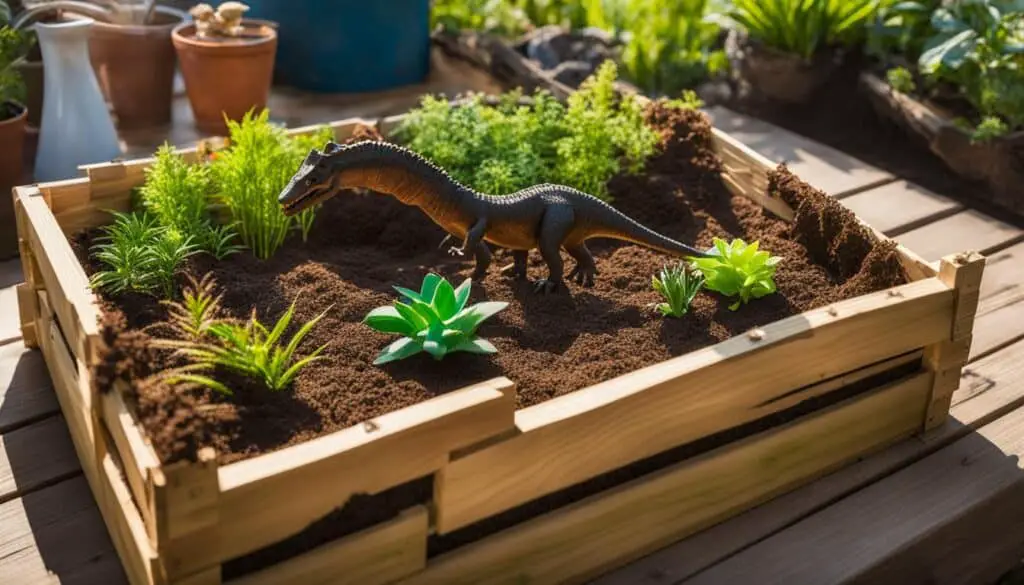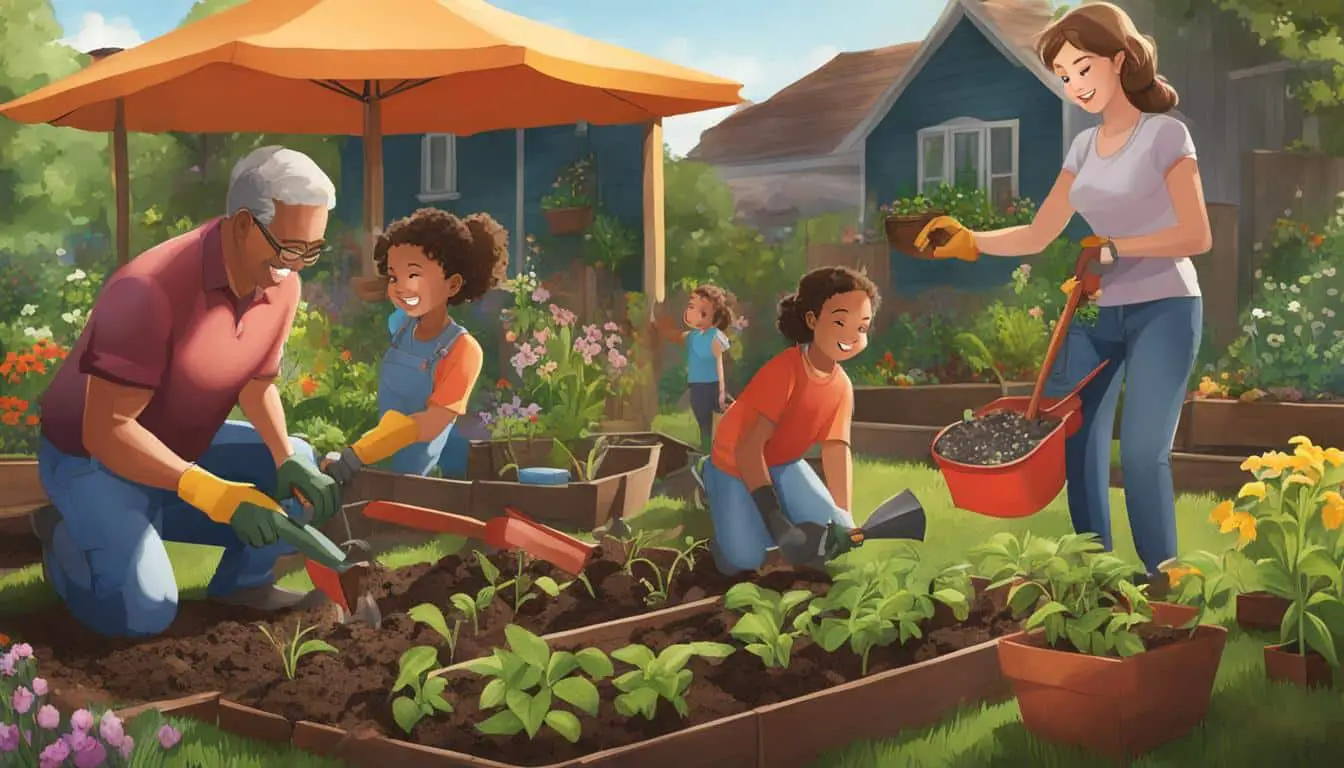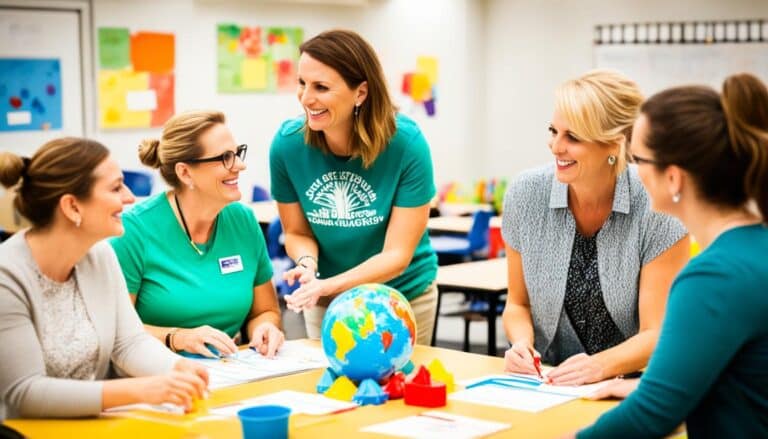Family Gardening Projects: Fun and Educational
Family gardening projects are a great way to engage the whole family in a fun and educational activity. From planting colorful containers to creating an enchanted garden, there are plenty of ideas to suit children of all ages. These projects not only get kids outdoors and away from screens but also teach them valuable skills like decision-making and gardening techniques. So let’s explore some family gardening project ideas that will have your kids excited to get their hands dirty!
Key Takeaways:
- Family gardening projects provide a fun and educational activity for the whole family.
- Engaging in gardening projects teaches children important skills and values.
- Planting colorful containers and creating enchanted gardens are just some of the exciting project ideas.
- These projects encourage kids to spend time outdoors and away from screens.
- Get ready to embark on exciting family gardening adventures with your kids!
Potting Up Colorful Containers
One fun and easy family gardening project is potting up colorful containers. Let your kids choose plants from the seasonal displays at the garden center and pick a cheerful pot to match. Whether it’s a colored plastic pot or a painted terracotta pot, let your kids get involved in the process. Help them fill the pot with peat-free multi-purpose compost and arrange the plants into an attractive display. Water regularly and watch as the container fills with vibrant flowers throughout the summer.
Tips for Potting Up Colorful Containers:
- Visit a local garden center with your kids to find a variety of plants and colorful pots.
- Encourage your children to choose plants with different heights, colors, and textures for an eye-catching display.
- Use peat-free multi-purpose compost to promote healthy plant growth and sustainability.
- Involve your kids in the process of arranging the plants in the pot, allowing them to express their creativity.
- Teach your children the importance of watering plants regularly to keep them thriving.
Engage your kids in the world of gardening by potting up colorful containers. This project not only adds a splash of color to your garden but also teaches your children about the joy and responsibility of nurturing living plants.
By potting up colorful containers, you provide an opportunity for your kids to learn about planting, care, and aesthetics. The vibrant flowers that bloom in these containers throughout the summer are a testament to their hard work and creativity. So head to the garden center and start creating your own stunning display of colorful containers today!
| Benefits of Potting Up Colorful Containers: | How It Helps: |
|---|---|
| Enhances visual appeal of your garden | Adds pops of color and variety to your outdoor space |
| Teaches children about plant care and responsibility | Encourages hands-on learning and a sense of ownership |
| Allows for creative expression | Children can design their own unique container displays |
| Creates a sense of accomplishment | Watching the plants thrive brings joy and satisfaction |
Creating an Enchanted Garden
Another exciting family gardening project is creating an enchanted garden. Help your children transform the base of a tree or a hollow in the ground into a magical space. Encourage them to collect stones for paths, twigs for fences, and add small plants like ferns around the trunk. They can tie ribbons to branches and even make a fairy door for a tree or wall by decorating a piece of cardboard or an ice-cream tub lid. This project will spark kids’ imagination and create a whimsical garden space.

Transforming a simple outdoor space into an enchanted garden can ignite children’s creativity and provide a magical haven for play and exploration. By working together as a family, you can easily create a whimsical atmosphere that will captivate the imagination of your little ones.
Paths and Fences
Start by helping your children gather stones from around the garden to create winding paths throughout the enchanted garden. These paths can lead to hidden treasures or secret spots where fairies and magical creatures might dwell. Additionally, collect twigs and small branches to construct fences that encircle the garden, adding a sense of mystery and separation.
Adding Plants and Greenery
To bring life and color to the enchanted garden, encourage your children to plant small ferns or other shade-loving plants around the base of the tree. This will create a lush and magical environment that feels like a hidden oasis. Make sure to provide adequate watering and care to help the plants thrive.
The Fairy Door
No enchanted garden is complete without a fairy door. Guide your children in creating a charming entrance for fairies to enter and exit. This can be done by decorating a piece of cardboard or an ice-cream tub lid with colorful paints, glitter, or other whimsical materials. Attach the door to the base of the tree or a wall, granting access to the mystical realm.
“An enchanted garden is a gateway to a world of make-believe and wonder, where dreams come alive and imaginations run wild.”
With the creation of an enchanted garden, your children will have a magical space to explore and play, fostering their creativity and imagination. This project allows them to connect with nature, discover the wonders of gardening, and experience the joy of bringing their fantasies to life.
Building a Dinosaur Crate Garden
If your little ones have a fascination with dinosaurs, they will absolutely love building a dinosaur crate garden. This project allows them to combine their love for prehistoric creatures with an educational gardening experience.
To begin, find a sturdy wooden crate that will serve as the foundation for the garden. Make it extra special by stenciling your child’s name on the crate, adding a personalized touch. This will make them feel connected to the project and excited to get started.
Next, let your child unleash their creativity by using colorful dinosaur figures as plant labels. As they choose scented herbs, like thyme, for the garden, each plant should be assigned its own dinosaur figure, with its name written on it. This not only adds a sensory element to the garden, but also helps your child learn about different types of plants.
When positioning the crate garden, make sure it is placed in a sunny spot, as most herbs thrive in direct sunlight. Regular watering is essential to keep the herbs healthy and happy.
Here is a step-by-step guide to building a dinosaur crate garden:
- Find a wooden crate
- Stencil your child’s name on the crate
- Select colorful dinosaur figures
- Choose scented herbs like thyme
- Assign each plant a dinosaur figure as a label
- Write the name of each plant on its corresponding dinosaur figure
- Position the crate in a sunny spot
- Water the herbs regularly
- Enjoy harvesting the herbs together
Not only will this project cultivate your child’s interest in gardening, but it will also ignite their imagination and fascination with dinosaurs. The combination of plant care and dinosaur-themed elements will create a sensory-rich experience that your child will remember for years to come.

Creating a Nature Den
Encourage your kids to build a nature den, an adult-free space where they can have fun and let their imagination run wild. Help them gather branches and arrange them to create walls that provide privacy. Make sure there’s an opening just wide enough for them to crawl through. Older children can design the den themselves and even try building a freestanding one. This project fosters creativity and independence while giving kids their own special space in the garden.
Creating a nature den is a wonderful way to connect children with the wonders of the natural world. It allows them to explore, play, and step away from technology, fostering a deep appreciation for nature. Building the den together strengthens family bonds and provides a safe haven where kids can let their imaginations soar.
Not only does a nature den provide a space for outdoor play, but it also promotes cognitive and physical development. Children learn problem-solving skills as they construct the den, develop fine motor skills when arranging branches, and immerse themselves in imaginative play while spending time in their secret hideaway.
Remember, the den doesn’t have to be elaborate. It can be as simple as creating a small enclosed area with branches or constructing a more complex structure using additional natural materials like twigs, leaves, and vines. The key is to prioritize privacy and create a cozy environment where children can feel a sense of ownership and freedom.
By encouraging your kids to build a nature den, you’re providing them with a space where their creativity can flourish, their imaginations can thrive, and their love for the outdoors can blossom. So roll up your sleeves, gather some branches, and let the building begin!
Benefits of Creating a Nature Den:
- Encourages outdoor exploration and play
- Fosters creativity and imagination
- Promotes cognitive and physical development
- Provides a sense of ownership and privacy
- Strengthens family bonds
Building a nature den gives children a special place where they can connect with nature, unleash their creativity, and create lifelong memories. It’s a magical escape that offers endless possibilities for adventure and fun!
Making Glass Jar Gardens
Glass jar gardens provide a perfect opportunity for little hands to get involved in a delightful family gardening project. Let your children explore their creativity by selecting an array of succulent plants from the garden center. These low-maintenance plants are not only visually appealing but also thrive in indoor environments like the windowsill.
To create a glass jar garden, start by filling the base of a large jar with gravel. This will ensure proper drainage for the plants. Next, add a layer of compost, providing essential nutrients for growth. Now comes the fun part – arranging the succulents in a display! Let your children use their imagination and design a mini garden within the jar.
Firmly plant the succulents in the compost, ensuring they are securely in place. Give them a little bit of water to promote initial growth. Then, top off the jar with a layer of gravel, which helps to retain moisture and prevents overwatering. The gravel also adds a decorative touch to the glass jar garden.
Place the jar on a bright indoor windowsill, where the succulents can receive ample sunlight. A sunny spot is crucial for their growth and vitality. Monitor the moisture levels regularly, taking care not to overwater. With proper care, you’ll be amazed at how these succulents thrive in their glass jar garden, bringing a touch of greenery and tranquility to your indoor space.
Tips for Succulent Care:
- Place the glass jar garden on a south-facing or east-facing windowsill to ensure the succulents receive sufficient sunlight.
- Water the succulents sparingly, allowing the soil to dry out between waterings. Overwatering can cause root rot.
- Keep an eye out for pests like mealybugs and scale insects. If you notice any infestations, gently wipe them off with a cotton swab dipped in rubbing alcohol.
- Rotate the glass jar occasionally to prevent the succulents from leaning towards the light source.
- Trim any dead or wilted leaves to maintain the overall appearance and health of the plants.
Creating glass jar gardens with your children not only fosters their interest in gardening but also provides a valuable learning experience about plant care and responsibility. Watching the succulents thrive in their mini ecosystem is rewarding for both children and adults alike.
Building a Bug Box
A bug box is an excellent project for attracting beneficial insects to your garden. Simply create an open-fronted box and let your kids gather materials like drilled logs, pine cones, stones, twigs, and dried grass to fill it. This will provide homes for solitary bees, ladybirds, woodlice, and other fascinating creatures. This project will not only educate your children about the importance of insects in the garden but also promote biodiversity.
Creating a bug box is a simple and rewarding activity that will benefit both your garden and the environment. By providing a safe habitat for beneficial insects, you can help control pests naturally and improve the overall health of your plants. Solitary bees, such as mason bees and leafcutter bees, are excellent pollinators and do not live in colonies like honeybees. Ladybirds, also known as ladybugs, are voracious predators of aphids and other garden pests. Woodlice help break down organic matter, contributing to soil health.
To build a bug box, start by finding or creating a wooden box with an open front. You can easily repurpose an old wooden crate or build a simple box using plywood. Make sure the box has multiple compartments or layers to accommodate different insect species. This will allow for a diverse range of beneficial insects to make their homes.
Next, let your kids gather natural materials to fill the bug box. Drilled logs or bamboo canes can provide nesting sites for solitary bees. Pine cones, stones, and twigs can create hiding places for ladybirds and woodlice. Dried grass or leaves can be used as additional shelter or bedding material.
Once the bug box is filled with materials, find a suitable location in your garden to place it. Ideally, choose a spot that receives some sunlight but is also protected from strong winds and heavy rain. Hang the bug box on a sturdy post, attach it securely to a tree, or place it on a raised surface.
Encourage your kids to observe the bug box regularly and document any insect activity they notice. They can keep a journal or take photos of the different creatures that take up residence. This will not only enhance their understanding of nature but also foster a sense of curiosity and appreciation for the tiny wonders that live in our gardens.
By building a bug box with your children, you are not only creating a habitat for beneficial insects but also instilling a sense of environmental stewardship. Your kids will learn the importance of biodiversity and the role insects play in maintaining a healthy ecosystem. Plus, they will have the satisfaction of knowing they are making a positive impact on their surroundings.
Tips for Building a Bug Box
- Use untreated, natural materials to ensure the bug box is safe for insects.
- Provide a mix of different materials to attract a variety of insects.
- Make sure the bug box is sturdy and securely mounted to prevent it from falling or being knocked over.
- Place the bug box in a quiet area of your garden, away from high foot traffic or disturbances.
- Encourage your kids to research and learn about the insects they are attracting to the bug box.
Building a bug box is a fun and educational project that will engage your children in the wonders of nature. It will not only create a haven for beneficial insects but also provide your family with countless opportunities for observation, learning, and appreciation of the natural world.
Conclusion
Family gardening projects offer a fantastic opportunity to bond with your loved ones and impart valuable skills to your children. Not only are these projects fun and educational, but they also provide a chance for kids to explore and connect with the natural world. Engaging in activities like potting up colorful containers, building bug boxes, and creating enchanted gardens can have a lasting impact on your family’s well-being.
By getting kids outdoors and away from screens, family gardening projects promote physical activity and mental stimulation. They teach children about plant life cycles, the importance of insects for pollination, and the satisfaction of nurturing living things. In addition, these projects foster a sense of responsibility, decision-making, and creativity in children as they actively contribute to the garden’s growth and maintenance.
So, dust off your gardening tools, gather your little ones, and embark on exciting family gardening adventures. Explore the wonders of nature, unleash your imagination, and enjoy quality time together. Let the joy and satisfaction of watching seeds grow and plants flourish bring your family closer while creating beautiful memories that will last a lifetime.
FAQ
What are family gardening projects?
Family gardening projects are activities that involve the whole family in fun and educational gardening activities. They provide an opportunity for children to learn valuable skills and engage with nature.
Why are family gardening projects beneficial?
Family gardening projects are beneficial because they get kids outdoors and away from screens, teach them valuable skills like decision-making and gardening techniques, and provide a fun and educational activity for the whole family to enjoy.
What are some ideas for family gardening projects?
Some ideas for family gardening projects include potting up colorful containers, creating an enchanted garden, building a dinosaur crate garden, making a nature den, creating glass jar gardens, and building a bug box.
How do I pot up colorful containers with my kids?
To pot up colorful containers, let your kids choose plants from the garden center and pick a cheerful pot. Help them fill the pot with peat-free multi-purpose compost and arrange the plants into an attractive display. Water regularly and enjoy the vibrant flowers throughout the summer.
How do I create an enchanted garden with my children?
To create an enchanted garden, help your children transform a space around a tree or in the ground. Encourage them to collect stones for paths, twigs for fences, and add small plants like ferns around the trunk. They can also tie ribbons to branches and make a fairy door. This project sparks imagination and creates a whimsical garden space.
What is a dinosaur crate garden and how do I build one?
A dinosaur crate garden is a project where kids can use a wooden crate to create a garden with dinosaur-themed plant labels. They can choose scented herbs and each plant should have its own dinosaur figure with its name written on it. Position the crate in a sunny spot, water regularly, and harvest the herbs together.
How can I help my kids build a nature den?
Help your kids gather branches and arrange them to create walls for a nature den that provides privacy. Make sure there is an opening just wide enough for them to crawl through. Older children can design and build a freestanding den. This project fosters creativity and independence.
How do I make glass jar gardens with my children?
To make glass jar gardens, let your children select succulent plants and fill the base of a large jar with gravel and compost. Arrange the succulents in a display, add a little water, and top with a layer of gravel. Place the jar on a bright indoor windowsill and watch them thrive.
What is a bug box and how do I build one?
A bug box is a project that attracts beneficial insects to the garden. It can be created by using materials like drilled logs, pine cones, stones, twigs, and dried grass. These materials provide homes for solitary bees, ladybirds, woodlice, and other fascinating creatures, promoting biodiversity in your garden.






